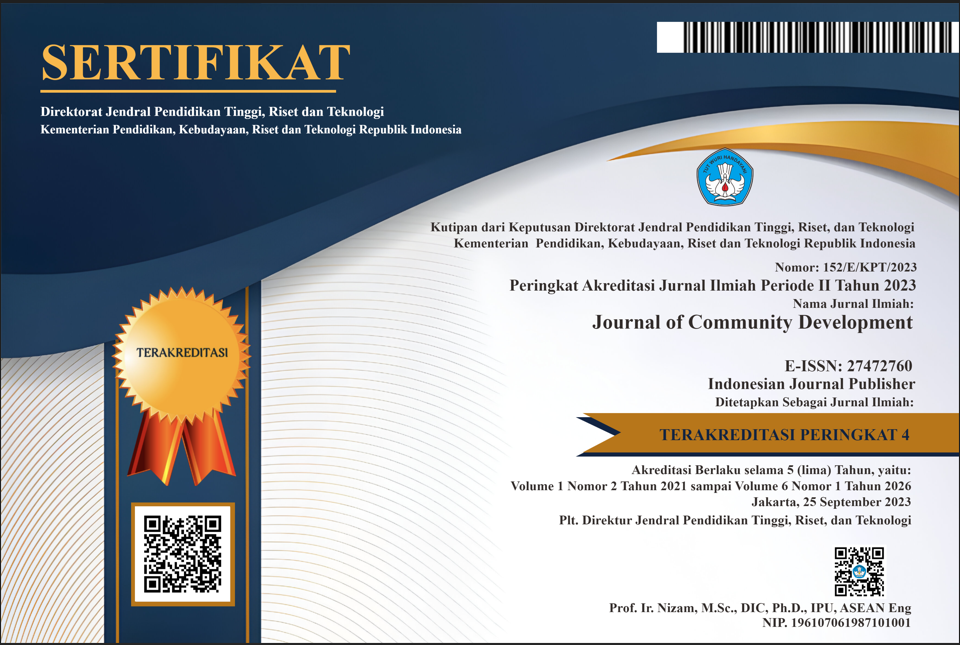Pemanfaatan Teknologi Informasi Dalam Mendorong Iklim Sekolah Positif Melalui Program Pencegahan Bullying
DOI:
https://doi.org/10.47134/comdev.v5i1.200Keywords:
Technology, School Climate, Bullying PreventionAbstract
Currently, there is an increase in bullying cases in secondary school environments such as junior high and high school, which can lead to negative impacts such as physical and mental disturbances for the victims. Bullying is an act of intimidation carried out by the stronger party against the weaker party, manifested in various forms of intimidating behavior. The purpose of the Community Service Program (PKM) at KKN is to provide education and socialization about the dangers of bullying, using technology such as videos depicting the negative impacts of bullying. In its implementation, PKM KKN uses the Participatory Action Research (PAR) method, which is a participatory method among citizens or communication through sharing approaches (the story-sharing method), in-depth interviews, and focused group discussions (FGD). The selection of this method is based on the understanding that socialization about bullying prevention involves identifying problems and implementing solutions directly related to action. The results of this counseling activity show: 1) Students can identify types of bullying, including: a) cyberbullying, b) verbal bullying, and c) physical bullying; 2) introduce anti-bullying campaigns to students; 3) create an environment that supports the development of students' personalities and social skills; and 3) encourage open communication between schools, teachers, and parents regarding the development of students' personalities and social skills.
Downloads
References
Adhinata, B. and Sawitri, Y. (2021) ‘Pembinaan Remaja Anti Perundungan pada Siswa Sekolah Menengah Atas di SMA Negeri 1 Tabanan’, Comunity Services Journal (CSJ), 4(1), pp. 124–133. Available at: https://doi.org/10.22225/csj.4.1.2021.124-133.
D, O. and J, B. (2018) ‘School climate and social and emotional learning: The integration of two approaches’, Pennsylvania State University. [Preprint].
Kementrian Hukum dan HAM Republik Indonesia, K.H. dan H.R.I. (2022) ‘Kementrian Hukum dan HAM Republik Indonesia. UU Nomor 35 Tahun 2014 tentang Perubahan atas UU Nomor 23 Tahun 2002 tentang Perlindungan Anak’. Available at: https://e-jurnal.peraturan.go.id/index.php/jli/article/download/407/287.
Konold, T., Shukla, D. and Etc (2017) ‘Racial / Ethnic Differences in Perceptions of School Climate and Its Association with Student Engagement and Peer Aggression’, Empricial Research, 46, pp. 1289–1303.
Mardianto (2018) ‘Membangun Iklim Sekolah Untuk Mereduksi Perilaku Agresi Siswa : Bullying dan Cyberbullying’, in Makalah Terapan yang disajikan dalam seminar akhir mata kuliah Pascasarjana. Universitas Negeri Malang: Universitas Negeri Malang, p. 3.
Maulida, H. and Darmiany (2022) ‘Analisis Dampak Perilaku Verbal BullyingTerhadap Kepercayaan Diri Siswa di SDN 20 Ampenan Tahun Pelajaran 2022/2023’, Jurnal Ilmiah Profesi Pendidikan, 7(3c), pp. 1861–1867. Available at: https://doi.org/10.29303/jipp.v7i3c.856.
Muluk, S. and etc (2021) ‘The impact of bullying on EFL students’ academic achievement at state Islamic universities in Indonesia’, Englisia Journal of Language Educational and Humanities, 8(2), pp. 120–137. Available at: https://doi.org/10.22373/ej.v8i2.8996.
Nurmalia, L., Nisa, B. and etc (2021) ‘Type, Cause, And Effect Of Bullying In A Girll Like Her Movie’, Jurnal Of Humanities and Social Studies, 5(3), pp. 247–251.
Rahmat, A. and Mirnawati, M. (2020) ‘Model Participation Action Research Dalam Pemberdayaan Masyarakat’, Universitas Negeri Gorontalo, 6(1), pp. 62–71.
Sapty Rahayu, F. (2012) ‘Cyberbullying sebagai Dampak Negatif Penggunaan Teknologi Informasi’, Jurnal Sistem Informasi, 8(1), pp. 22–29. Available at: https://doi.org/10.21609/jsi.v8i1.321.
Unicef, U. (2024) ‘Perundungan Indonesia: Fakta-fakta Kunci, Solusi dan Rekomendasi’, p. 1.
Widiyanti, W. (2019) ‘Mengenal Perilaku Bullying di Sekolah’, Islamic Counseling, 3(1), pp. 56–68. Available at: https://doi.org/10.29240/jbk.v3i1.801.
Widya Rachma, A. (2022) ‘Upaya Pencegahan Bullying Di Lingkup Sekolah.’, Jurnal Hukum dan Pembangunan Ekonomi, 10(2). Available at: https://doi.org/10.20961/hpe.v10i2.62837.
Downloads
Published
How to Cite
Issue
Section
License
Copyright (c) 2024 Munakhiroh El Hajar, Winda Nindya Putri, Siskha Putri Sayekti

This work is licensed under a Creative Commons Attribution 4.0 International License.







